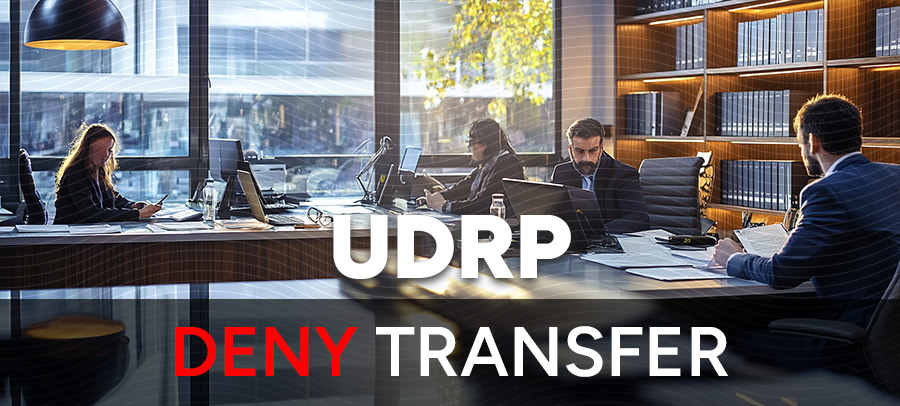Farmbot Holdings Pty Ltd claimed that Ranchbot.com infringed on its RANCHBOT mark, which it began using in 2021. The company argued that the domain was acquired in 2023 by the Spanish Respondent, pointing to a $500,000 sale offer and a “10 BTC” landing page as evidence of bad faith.
The Panel, however, found that Ranchbot.com was registered in 2014, years before the Complainant adopted the RANCHBOT name or filed its trademark. Independent research confirmed that the Respondent has held the domain since at least 2015, undercutting any claim of targeting.
With no proof of bad faith registration or use, the Panel dismissed the case and also declined to find Reverse Domain Name Hijacking, concluding the Complaint was not entirely unreasonable.
Final decision: Deny the transfer of the domain Ranchbot.com to the Complainant.

Copyright © 2025 DomainGang.com · All Rights Reserved.ARBITRATION AND MEDIATION CENTER – ADMINISTRATIVE PANEL DECISION
Farmbot Holdings Pty Ltd v. Christian Sampson
Case No. D2025-21451. The Parties
The Complainant is Farmbot Holdings Pty Ltd, Australia, represented by McCoy Russell LLP, United States of America (“United States”).
The Respondent is Christian Sampson, Spain.
2. The Domain Name and Registrar
The disputed domain name ranchbot.com is registered with Sea Wasp, LLC (the “Registrar”).
3. Procedural History
The Complaint was filed with the WIPO Arbitration and Mediation Center (the “Center”) on May 31, 2025. On June 2, 2025, the Center transmitted by email to the Registrar a request for registrar verification in connection with the disputed domain name. On June 3, 2025, the Registrar transmitted by email to the Center its verification response disclosing registrant and contact information for the disputed domain name which differed from the named Respondent (Not known by Complainant) and contact information in the Complaint. The Center sent an email communication to the Complainant on June 3, 2025, providing the registrant and contact information disclosed by the Registrar, and inviting the Complainant to submit an amendment to the Complaint. The Complainant filed an amended Complaint on June 6, 2025.
The Center verified that the Complaint together with the amended Complaint satisfied the formal requirements of the Uniform Domain Name Dispute Resolution Policy (the “Policy” or “UDRP”), the Rules for Uniform Domain Name Dispute Resolution Policy (the “Rules”), and the WIPO Supplemental Rules for Uniform Domain Name Dispute Resolution Policy (the “Supplemental Rules”).
In accordance with the Rules, paragraphs 2 and 4, the Center formally notified the Respondent of the Complaint, and the proceedings commenced on June 11, 2025. In accordance with the Rules, paragraph 5, the due date for Response was July 1, 2025. The Respondent did not submit any response. Accordingly, the Center notified the Respondent’s default on July 2, 2025.
The Center appointed Jeremy Speres as the sole panelist in this matter on July 8, 2025. The Panel finds that it was properly constituted. The Panel has submitted the Statement of Acceptance and Declaration of Impartiality and Independence, as required by the Center to ensure compliance with the Rules, paragraph 7.
The Panel issued Procedural Order No. 1 on July 10, 2025, requesting the Complainant to provide information regarding its claimed unregistered trademark rights. The Complainant responded on July 15, 2025.4. Factual Background
The Complainant, founded in 2000, offers water technology solutions and services to farmers. It operates under the FARMBOT mark in Australia, and, since 2021, has operated in the United States under its RANCHBOT mark. Its website is hosted at the domain name ranch-bot.com.
The Complainant’s RANCHBOT mark is registered in various jurisdictions, including International Trademark Registration No. 1608345 RANCHBOT in classes 9, 37, and 42, designating the United States, and having a registration date of July 21, 2021.
The disputed domain name was registered on May 2, 2014, and currently redirects to brandabledomains.com, which in turn resolves to a “403 Forbidden” error page. The Complainant’s evidence establishes that on June 1, 2023, the disputed domain name redirected to a website at which stated: “Min offer 10 BTC”.
5. Parties’ Contentions
A. Complainant
The Complainant contends that it has satisfied each of the elements required under the Policy for a transfer of the disputed domain name.
Notably, the Complainant contends that the disputed domain name was registered and has been used in bad faith in order to take advantage of the Complainant’s well-known mark for the purposes of selling it at a profit to the Complainant.
The Complainant also argued in response to the Procedural Order No. 1 that it has been using the trademark since at least 2021. The Complainant contends that the evidence suggests that the Respondent acquired the disputed domain after the trademark right accrued in 2023. The Complainant explained that in 2023, the disputed domain name redirected to a site in which the following message was displayed “Min offer 10 BTC”. It also argued that it was reasonable to assume the Respondent acquired the disputed domain shortly before its known use in 2023.
Additionally, it referred that the Respondent offered to sell the disputed domain name for USD 500,000, which exceeded the good faith valuation, and described this as an extortionate tactic.
B. Respondent
The Respondent did not reply to the Complainant’s contentions.
6. Discussion and Findings
A. Identical or Confusingly Similar
It is well accepted that the first element functions primarily as a standing requirement. The standing (or threshold) test for confusing similarity involves a reasoned but relatively straightforward comparison between the Complainant’s trademark and the disputed domain name. WIPO Overview of WIPO Panel Views on Selected UDRP Questions, Third Edition, (“WIPO Overview 3.0”), section 1.7.
The Complainant has shown rights in respect of a trademark or service mark for the purposes of the Policy. WIPO Overview 3.0, section 1.2.1.The entirety of the mark is reproduced within the disputed domain name. Accordingly, the disputed domain name is identical to the mark for the purposes of the Policy. WIPO Overview 3.0, section 1.7.
The Panel finds the first element of the Policy has been established.
B. Rights or Legitimate Interests
Given the Panel’s findings in relation to the third element below, there is no need to consider the second element.
C. Registered and Used in Bad Faith
The disputed domain name was registered in 2014. The Complainant’s earliest trademark application was filed, and the Complainant began using its RANCHBOT mark, in 2021. The Complainant’s own domain name, ranch-bot.com, was registered in 2020.
In Procedural Order No. 1, the Panel invited the Complainant to provide evidence which would demonstrate the Complainant’s earliest unregistered trademark rights and/or a likelihood that the Respondent registered or acquired the disputed domain name in anticipation of the Complainant’s trademark rights. The Complainant’s response was to claim that, because the only evidence of active use of the disputed domain name was its redirection to a website in 2023 offering it for sale, it is reasonable to infer that the Respondent only acquired the disputed domain name shortly before this use in 2023. No further evidence supporting the contention that the Respondent acquired the disputed domain name after the Complainant obtained trademark rights was provided.
In accordance with its powers of independent research articulated inter alia in paragraphs 10 and 12 of the Rules, the Panel has considered publicly available WhoIs history records for the disputed domain name. These indicate that the current Respondent, with the same name and email address, has owned the disputed domain name since at least as early as 2015, long before the Complainant began using its mark or acquired registered trademark rights.
There is no evidence in the record indicating how the Respondent could have been aware, at the time it registered or acquired the disputed domain name either in 2014 or 2015, of the Complainant’s intentions to adopt its RANCHBOT mark in 2021. Given the conjunctive nature of the bad faith element, requiring both bad faith registration and bad faith use, the Complaint cannot succeed.
The Panel finds the third element of the Policy has not been established.
D. Reverse Domain Name Hijacking
Paragraph 15(e) of the Rules provides that, if after considering the submissions, the Panel finds that the Complaint was brought in bad faith, for example in an attempt at Reverse Domain Name Hijacking (“RDNH”) or to harass the domain-name holder, the Panel shall declare in its decision that the Complaint was brought in bad faith and constitutes an abuse of the administrative proceeding. The mere lack of success of the complaint is not, on its own, sufficient to constitute reverse domain name hijacking. WIPO Overview 3.0, section 4.16.
The Panel has considered whether the Complaint was brought in bad faith, as it is entitled to do despite that the Respondent has not requested such a finding. WIPO Overview 3.0, section 4.16.
The Complainant’s trademark rights, and first usage of its mark, long postdate registration or acquisition of the disputed domain name by the Respondent, and the Complainant is represented by counsel, which are both relevant factors supporting a finding of RDNH. WIPO Overview 3.0, section 4.16.
However, the Complainant’s argument that the disputed domain name was only acquired by the Respondent shortly before the disputed domain name was used in 2023 is not entirely without supporting evidence. The fact that the Internet Archive only shows use of the disputed domain name in 2023 despite its registration in 2014 may have suggested to the Complainant that the disputed domain name was acquired by the Respondent then. Ultimately the evidence did not support a firm conclusion in the Complainant’s favor on this point, which impacts the outcome of the case. The Complainant also claims that the Respondent offered to sell the disputed domain name to the Complainant “[a]t one point” for USD500,000. Despite the Complainant not providing any evidence supporting this contention, the Panel considers that it is unlikely to have been a wholesale fabrication on the Complainant’s part given that the disputed domain name did in fact redirect to a page offering it for sale previously. If the Respondent did indeed offer the disputed domain name to the Complainant, then this may at least provide some support for the Complainant’s apparent belief that the disputed domain name was registered with a view to selling it to the Complainant, although the Panel has no evidence before it and makes no findings in this regard.
This all suggests that it was not entirely unreasonable of the Complainant to bring the Complaint, and that it is possible that the Complainant genuinely believed this to be a case of cybersquatting.
Although it is close on balance of probabilities, bearing in mind that the Respondent has not responded nor requested a finding of RDNH, the Panel does not consider it more likely than not that the Complaint was brought in bad faith.
7. Decision
For the foregoing reasons, the Complaint is denied.
/Jeremy Speres/
Jeremy Speres
Sole Panelist
Date: July 23, 2025










